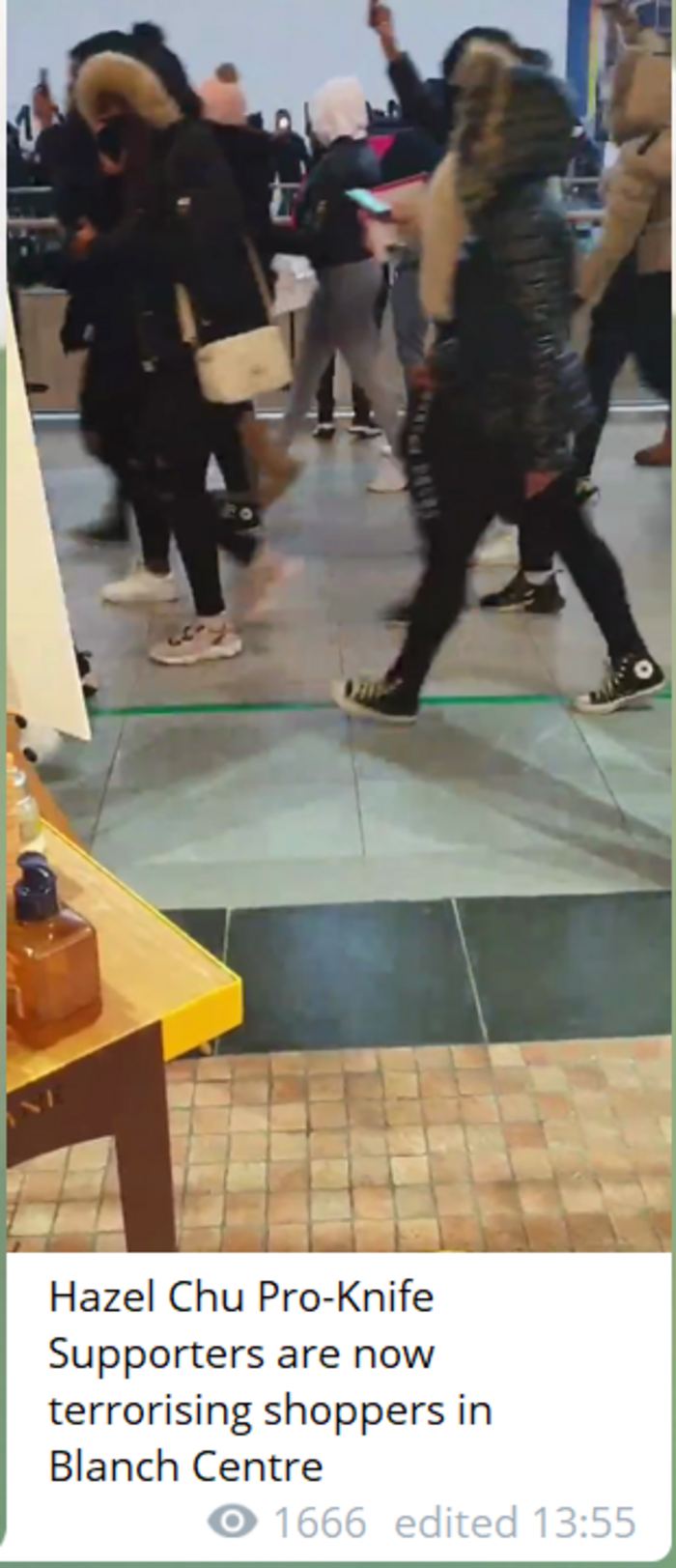Trial by Telegram: Ireland's far right mobilising on 'privacy-first' messaging app
Final part in a four-part investigation into the far right in Ireland analyses the growth of US-style tactics used by Irish influencers on the platform.

This is the final part of a four-part series published by Noteworthy and The Journal – in conjunction with the Institute for Strategic Dialogue (ISD) – on the growth of far-right ideology on Irish online networks, and its influence on wider public opinion.
Here, Aoife Gallagher and Ciarán O’Connor, analysts with the ISD, and Noteworthy’s Susan Daly chart the explosion of far-right activity on messaging app Telegram over the past year.
FAR-RIGHT ACTIVITY with an Irish focus snowballed on the messaging platform Telegram in 2020, new research has found.
Analysts at the Institute for Strategic Dialogue (ISD) carried out a comprehensive analysis of far-right content on the messaging app Telegram as part of our Eyes Right series on the influence that far-right efforts are having on Irish public opinion.
Telegram has existed since 2013 but is currently experiencing an upsurge of users, attracted by its strong privacy policies, and mix of encrypted ‘secret’ chats and ‘loudhailer’ channels which can broadcast content to up to 200,000 followers.
The app has previously had to take action on the use of its features by terror group Isis to spread propaganda and direct terrorist attacks. In 2019, Europol recognised Telegram for its “considerable effort” in rooting out users and content that glorified “violent extremism”.
However, Telegram has remained a destination for other radical and extremist groups; this ISD report from last year shows how the platform has been used by white supremacists to post a range of extremist material and share guides that help individuals prepare for violence. (In the aftermath of the 6 January storming of the Capitol Building in the US, Telegram confirmed it had blocked a number of channels it believed were inciting violence.)
While the ISD plans to publish the full report on its Irish findings later this month, Noteworthy and The Journal can today reveal that:
-
Researchers identified 34 Irish Telegram channels used to promote ethnonationalist, far-right content. These channels support nativist nationalist ideologies, promote conspiracy theories targeting political opponents, direct hate towards ethnic and religious minorities, disseminate COVID-19 misinformation and some also support violence against the State;
-
In 2020, Telegram channels categorised by the ISD as promoting far-right content distributed 60,377 messages; in 2019, this number was just 801, representing an increase of 7,438% in just one year among these communities;
-
Almost one in 10 messages posted by Irish anti-lockdown and Covid conspiracy Telegram channels originated from far-right sources;
-
Tactics designed to influence wider public information beyond the platform included encouraging users to impersonate Green Party voters and sow dissent about a government minister, the spreading of false information designed to ‘trick’ media into republishing it, and directions on how to incite ‘rivals’ to street violence.
https://public.flourish.studio/visualisation/5574977/
Radical right wing voices have emerged in Ireland on social media platforms in the past few years, many with an original focus on YouTube, Twitter and Facebook. In the first part of our Eyes Right series on far-right activity online here, we saw how influencers and groups zoned in on particular flashpoints, dominating the online narrative and contributing to local tensions.
In the past year, some of these voices have withdrawn or been removed from those platforms as part of a global – and belated – crackdown on accounts which the social media giants deem to be inciting hatred, promoting unrest or otherwise breaching ‘community’ guidelines.
Many of these personalities and groupings – and their attendant ideologies – moved swiftly to Telegram, if they were not there already.
The combination of being able to broadcast to large numbers of people (up to 200,000 in a channel), while simultaneously sending encrypted messages that are resistant to moderation, has proven an attractive proposition.
***
Seeding, sharing, spreading
In order to assess the proliferation of far-right content on Telegram, ISD identified three public channels which are associated with Irish ethnonationalist content. Telegram channels often share material that links to related public channels that share the same interests, ideologies or audiences. Using these three ‘seed’ channels, a further 31 similar public communities on the platform were added into the analysis.
Within these channels, researchers identified two distinct categories of channel: discussion threads that enabled group chats within a community, and one-to-many content banks that served as repositories for ideological content that typically featured misleading, false and incendiary material.
Based on qualitative analysis of the content in the identified channels, they were split into further categories: Ethnonationalist/anti-immigrant channels, far-right conspiracy theories, far-right influencer, far-right political groups, literature/content (material that promotes nativist Irish heritage, literature and culture), and doxxing. (See the third part of our series which speaks to Irish victims of online doxxing here.)
https://public.flourish.studio/visualisation/5574894/
A further revelation in organising these streams of content was the extent to which distributors of far-right material were intersecting with Irish anti-lockdown and Covid-19 conspiracy channels. Of the nine of these channels identified, 4,584 messages were posted between April 2020 – when the first such channel appeared – and 3 February 2021.
In total, 413, or 9%, of all messages posted in Irish Covid-19 conspiracy Telegram channels originated from a far-right source.
Of these, 263 messages were forwarded from other far-right Telegram channels (both Irish and international channels) and 150 featured content produced by a far-right entity, highlighting the degree to which extremist and conspiratorial communities overlap within the Irish Telegram ecosystem.
By contrast, 13 messages, or 0.2%, shared by these Telegram channels featured content from a far-left source.
The crossover between ethnonationalist channels and anti-lockdown/anti-mask activity offline emerges when so-called anti-mask rallies in Dublin were heavily promoted on Telegram ahead of 12 September.
The most-widely shared message among the channels during the analysed period was a post originally published on an anti-lockdown channel on 11 September, and then shared at least 10 times among ethnonationalist channels, which urged followers to attend the protests in Dublin the following day. The post urged people “to get out on the streets”.
Study of messages on these channels at that time also reveals a number of trends that are a hallmark of contemporary far-right movements internationally, namely:
-
Claims of a ‘false flag’ operation in relation to one incident at a rally;
-
Hostility towards mainstream media as a central feature of activity on that day;
Anti-Semitic slurs against counter-protestors; -
An intense cross-channel focus on the topic – 24 of the 34 channels under scrutiny were active on the topic during that week in September
Such amplification and co-ordination across channels can also be seen gathering strength on other specific topics, and around targeted individuals.
More worryingly, there is evidence that far-right actors on Telegram are orchestrating specific campaigns as entry points to pushing wider racist and homophobic conspiracies.
The following are two case studies tracked by ISD researchers to explore the tactics involved.
Roderic O’Gorman slurs and wider LGBTQ+ conspiracies
Telegram acted as a megaphone for attacks against Minister for Children Roderic O’Gorman, with channels promoting homophobic content to their audiences and to amplify conspiracy theories against him that were first posted on a small political discussion forum.
On 27 June 2020, the same day O’Gorman was appointed to the cabinet of the new government coalition, a far-right Telegram channel posted a screenshot image of television coverage showing O’Gorman celebrating his election as a TD earlier that year by kissing his partner, Ray Healy. The channel added the caption “Minister for Children” to the post, sowing the seeds for the beginning of the campaign of homophobia against O’Gorman.
The image spread across other social media platforms, particularly Facebook, but using the same image and caption posted on Telegram a day earlier. Telegram was also a central forum through which far-right actors boosted content that claimed O’Gorman supported the views of Peter Tatchell, a veteran LGBTQ activist who has been criticised for comments he made in the past regarding sex between adults and children, which he has clarified.
Online posts highlighting links between O’Gorman and Tatchell were first posted on a fringe political forum on 30 June. Within one hour, the forum post was shared on a highly influential far-right Irish Telegram channel and by evening, the content was spreading across Twitter, including in tweets by Irish Freedom Party leader Hermann Kelly. They were later shared by the right-wing Renua party who also called on O’Gorman to resign.
Photos of O’Gorman and Tatchell at Dublin’s 2018 Pride festival were shared in support of the claim that the TD supported Tatchell’s views.
In a statement about what he called the “far-right” smear campaign against him, O’Gorman said: “I was surprised to read some [of] the quotes from the ’90s, which I had not read before. Any of these views would be completely abhorrent to me.”
Three different petitions calling for O’Gorman to resign over his links to Tatchell were shared 18 times cumulatively across Irish Telegram channels during this period. One ethnonationalist channel encouraged followers to sign the petition and then advised them to impersonate Green Party voters and spread dissent about O’Gorman to members of the party (see below).

Irish far-right Telegram channels were also quick to amplify remarks about O’Gorman’s connection to Tatchell made by actor John Connors who called it the “political scandal of the year” and claimed that O’Gorman was “playing the victim card and claiming homophobia”. Connors later apologised to O’Gorman for his remarks.
The smear campaign levelled against O’Gorman through accusations linking him to Tatchell’s views acted as an entry point for far-right Telegram channels to then carry out a wider campaign pushing baseless claims that framed LGBTQ activists as supportive of Tatchell and paedophilia.
A video of Tatchell speaking at an event during Pride in 2018 was shared by one far-right channel to support the claim that Sinn Fein Senator Fintan Warfield, LGBTQ rights campaigner Justin McAleese, Fine Gael Senator Martin Conway and trans rights activist Sara Phillips all supported the British LGBTQ activist too.
The same channel also shared a tweet that asked “why were children cartoon characters used for Dublin Pride events in 2018” to support their claims that there is a link between LGBTQ promotion and paedophilia.
The continued promotion of this link culminated on 11 July 2020, when ‘anti-paedophile’ rallies were organised by far-right groups in Dublin.
On 5 July, the Irish Freedom Party endorsed a ‘Hands Off Our Kids’ rally for 11 July 2020 in Dublin, while supporters of the National Party promoted a ‘March for Innocence’ to be held on the same day. One promotional poster shared on Telegram stated that the protests were to “demand the immediate removal from government of those complicit in child abuse, coverups and peadophilia activism”.
Campaigning in defence of children is a regular tactic adopted by far-right communities. Recently, in the summer of 2020, supporters of the QAnon conspiracy theory started to hijack hashtags associated with the Save the Children movement, as reported in the New York Times, in a tactical move that was credited with bringing the conspiracy to a much wider audience. QAnon itself has its roots in the earlier widely debunked child exploitation conspiracy theory, Pizzagate.
Since 2016, alt-right and far-right activists have routinely accused liberal, multicultural or left-wing politicians or groups of supporting or enabling paedophilia as a way of spreading disinformation and accusing opponents of what is arguably regarded by most societies as the worst crime imaginable. In launching and propagating a disinformation campaign against Roderic O’Gorman, Irish far-right channels on Telegram sought to do the same.
Disinformation beyond the death of George Nkencho
The second part of our Eyes Right series touched on the disinformation campaign around the shooting by gardai of 27-year-old George Nkencho on 30 December 2020 in Clonee, Co Dublin.
The killing of George Nkencho, who was suffering from mental health difficulties and allegedly brandishing a knife and threatening gardaí before he was shot, is currently under investigation by Gsoc (Garda Ombudsman).

In the hours and days following the incident, claims circulated widely online that attempted to frame Nkencho as a violent criminal with multiple convictions. These claims were found to be false.
Five hours after the news broke, clear directions were posted across Telegram channels that instructed followers how to react to the shooting incident. Followers were told to avoid going to protests or getting into discussions with people about the incident. Instead, they were told, “stay home… make memes, dig up stats, turn on your VPN and get trolling”.
The directions also included instructions on how to use the shooting to stir up racial tensions with others on social media. The language and phraseology used by these channels mimicked that associated US and international far-right and white supremacist ideology.
As well as racial slurs and memes, there were posts which named the shooter as “National Party member Seamus O’Hyde” (false). This is a tactic regularly used on the white supremacist imageboard 4chan in the aftermath of mass shootings in the US to trick journalists and others into reporting and sharing false information.
A number of different false claims related to Gardai were circulated on the channels. Initially, ethnonationalist/anti-immigrant channels proposed spreading the claim that the Garda officer who shot Nkencho was an “Eastern European LGBT ban [female] Garda” and encouraged followers to incorporate these details into the narratives that they were spreading online.
Such messages included instructions to push “both narratives” – claims of a “Gaelic supremacist attacking a foreigner” and a “white liberal attacking a homophobe”, showing the tendency of these movements to attempt to stir up any kind of racial or ethnic tensions.
After the actual Garda officer’s identity was shared online, the groups shifted from smearing the Gardai to defending the police force and claiming that “BLM terrorists” were sharing the officer’s identity. They also attempted to smear a slew of left-wing politicians and claimed that “Hazel Chu, Paul Murphy, Alan Kelly and Saoirse McHugh support this”, with “this” meaning the supposed illicit sharing of the officer’s identity. (To be clear, this was not true.)

Left wing politicians were frequently mentioned and targeted with hate within these discussions as a result of sympathies they expressed towards the family, including Lord Mayor of Dublin Hazel Chu, who was mentioned in 16% of messages.
Chu is a consistent target of Irish far-right activists over her support for left-wing political ideologies and her Chinese heritage. Chu was frequently referred to as “Pro-Knife Hazel Chu” among far-right channels (see image above, from Telegram) within the data set after she tweeted her sympathies to the family of George Nkencho. The channels also used this term to refer to BLM activists protesting in the days after the shooting.
There was also an attempt to smear disinformation researchers – including the ISD and The Journal FactCheck as being responsible for spreading false claims when in fact these organisations had debunked them.
Factcheckers and news organisations were, it was claimed, “leaking fake pics to Nationalists to spread disinformation”. In support of this allegation, these Telegram channels shared a photo that they claimed showed the injuries sustained by the shop worker in an attack prior to Nkencho’s death. In fact, the image has no relation to this incident and actually showed an Everton football club fan who was attacked before an FA Cup game in January 2019, as reported by The Journal.

Further false claims that stated that ISD was “spreading fake WhatsApp messages” were also shared by Irish far-right channels on Telegram, along with conspiracy theories alleging that ISD is “funded by MI5” and that this report’s authors were hired to apply the “RIC Model of policing and intelligence”. None of these claims hold any truth.
In all, ISD recorded 4,397 posts across 28 channels in the week following the shooting of George Nkencho, with 3,072 of these consisting of text-based messages. One-fifth of these were specifically about George Nkencho and his death. The posts were sent in 21 Telegram channels, 17 of which were categorised as ethnonationalist/anti-immigrant and four which were categorised as channels sharing far-right conspiracy theories.
***
Attacks and smear campaigns, based on unsupported, illusory claims against the media and extremism researchers are a common tactic used by far-right groups, politicians and supporters across the world.
Such activity observed among Irish far-right Telegram channels as seen here is no different and is also a common approach taken by the communities observed on Telegram for this report. Noteworthy asked Telegram to comment on the findings of the ISD analysis and whether the company considered there had been a breach of its principles or guidelines. No response had been received at the time of publication.
When an update to terms and conditions at rival messaging service Whatsapp caused privacy concerns among users at the beginning of 2021, Telegram was one of the beneficiaries of exiting clients. It recorded 25 million new users in 72 hours alone, 27% of these from Europe.
At the time, Telegram’s founder Pavel Durov said Telegram had become a “refuge” for those seeking a platform “committed to privacy and security” and assured new users that his team “takes this responsibility very seriously”.
How to reconcile that commitment to privacy – something Irish far-right channels are counting on – with responsibilities around platforming extremism is a headache Telegram continues to face.

***
This investigation was carried out by investigative platform Noteworthy, our colleagues at The Journal and the Institute of Strategic Dialogue.
The idea for this investigation was proposed and funded by you, our readers, as well as with support from the Noteworthy general fund to cover additional costs.
You can support our work by submitting an idea, funding for a particular proposal or setting up a monthly contribution to our general investigative fund HERE>>







